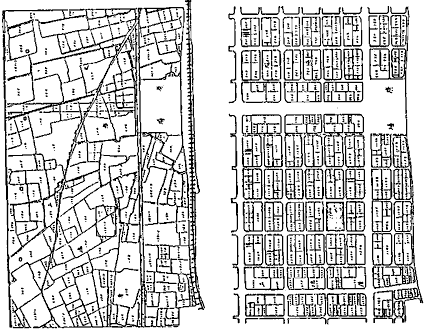|
||||||||||||
Setting It Up
|
||||||||||||
|
|
||||||||||||
| Included are several summaries of articles dealing with ways of carrying out land readjustment. One details an example from Sri Lanka on reblocking together with the community. A second deals with Land Sharing in Bangkok where the slum dwellers meet with the land owner and agree on a reorganization, and a third deals with temporary removal and rationalization of the plot layout, or Land Pooling as it is sometimes called.
(See in Glossary: Land Pooling, Land Readjustment, Land Reconstitution) |
||||||||||||
|
|
||||||||||||
Land Sharing in Bangkok
|
||||||||||||
|
|
||||||||||||
| A unique approach to the resolution of slum eviction conflicts has evolved in Bangkok. Slum dwellers faced with imminent eviction have organized and bargained successfully for a share of the land they currently occupy, and landlords – usually after protracted negotiations –have agreed to sell or lease them the land. | ||||||||||||
The five basic requisites of land sharing are:
Land sharing is increasingly viable in the following situations:
Land sharing usually results in major improvements in housing and a significant increase in asset formation. The conditions for its success are assessed by comparing land sharing slums with other slums with potential for land sharing. Land sharing is not successful where communities are weak, and once implemented may result in the resale of some of the houses, which then command a higher market value. |
||||||||||||
|
|
||||||||||||
| Land Sharing in Bangkok Four Examples |
||||||||||||
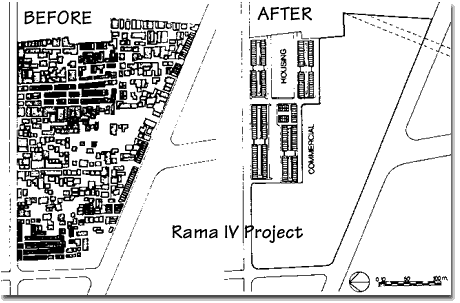 |
||||||||||||
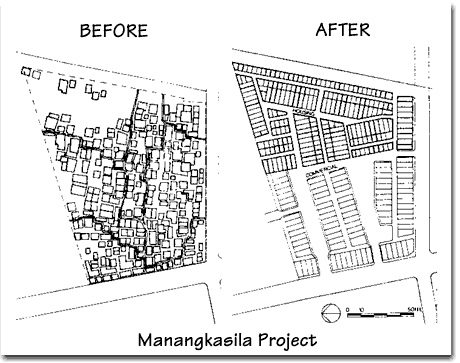 |
||||||||||||
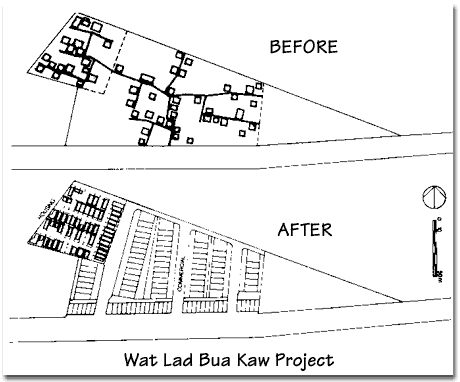 |
||||||||||||
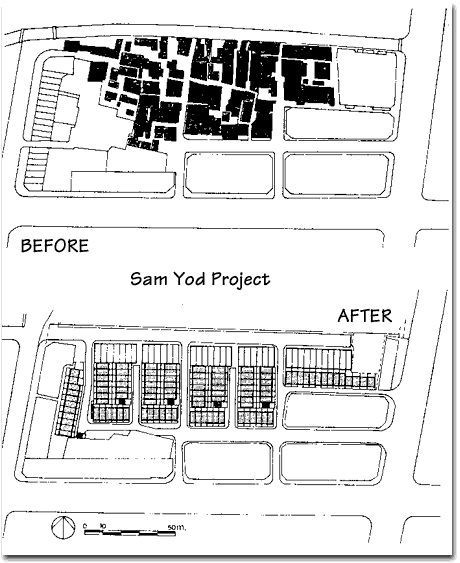 |
||||||||||||
Drawings from: |
||||||||||||
|
|
||||||||||||
| Land Pooling: The Benefits, Conditions for Success, and Steps
|
||||||||||||
| Urban land pooling is a technique for carrying out the unified servicing and subdivision of separate landholdings for planned urban development. It is also know as urban land consolidation, land readjustment, land replotting, and land redistribution in particular countries because it involves these processes. It is widely used in Japan, South Korea and Taiwan and in some cities in Australia and Canada. A somewhat similar technique known as plot reconstitution is used in some cities in India.
Land pooling can be used for: consolidating separate landholdings for their unified subdivision for the planned pattern of urban land uses; achieving the timely servicing and subdivision of urban-fringe landholdings to a good standard; and for financing the cost of providing the road and public utility service networks out of the related land value increases. ensuring an adequate supply of land for new housing development. The Benefits of Land Pooling 1. To achieve a good standard of subdivision design and engineering works; Pooling can therefore provide real benefits, but they are not automatic benefits. Each project has to be soundly conceived, properly organised and well-managed. Most of the benefits listed can be provided by individual land pooling projects. The final two benefits, achieving progressive urban expansion and an adequate supply of land for new housing development, depend upon successfully programming and coordinating the various pooling projects with the other land subdivision projects in-progress into a coherent program for metropolitan expansion and land supply. The pooling technique can also be used to provide land for low-income housing. This could be done by allocating a proportion of the land area in each project for sale at cost or below cost to the public housing authority for the provision of low-income housing. Alternatively, the government agency managing the pooling project could be allocated a proportion of the new sites for low-income housing purposes in recognition of its role as the project manager contributing its government powers and status to the successful implementation of the project. The formula for determining the proportion of the land area or new sites to be allocated for low-income housing would have to take into account the amount of the net land value gain going to the landowners. Conditions for Successful Land Pooling i. The relevant local government (or other government pooling agency) is genuinely interested in achieving orderly urban development to a planned pattern of urban land use; Assuming that these general conditions are met then each pooling project will also need to be financially viable and soundly managed. Each project will need to generate land value increases sufficient to cover the project costs and leave the landowners with a significant land value gain. Each project will need to be well-managed in order to achieve efficient and economical land servicing and subdivision. This financial viability and sound management is assisted by the preparation and publication of a pooling scheme for each project. The scheme should be supported by a financial plan. The pooling agency will need to liaise and consult with the landowners and government works authorities, particularly in preparing the scheme, in order to obtain their support and cooperation. |
||||||||||||
 Bangkok, Thailand: King Petch walk. Thailand has extensive, successful experience in the land pooling process. Photo: R. Goethert. |
||||||||||||
| Land Pooling Steps
The main steps and stages in carrying out a typical pooling project can be listed as follows: 1. Identification of the group of adjoining landholdings for pooling which is then designated as the land pooling area; |
||||||||||||
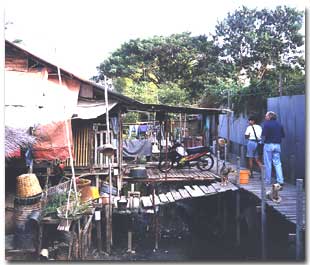 Chiang Mai, Thailand: Land pooling has been especially successful in Thailand. Photo: R. Goethert. |
||||||||||||
|
||||||||||||
|
||||||||||||

